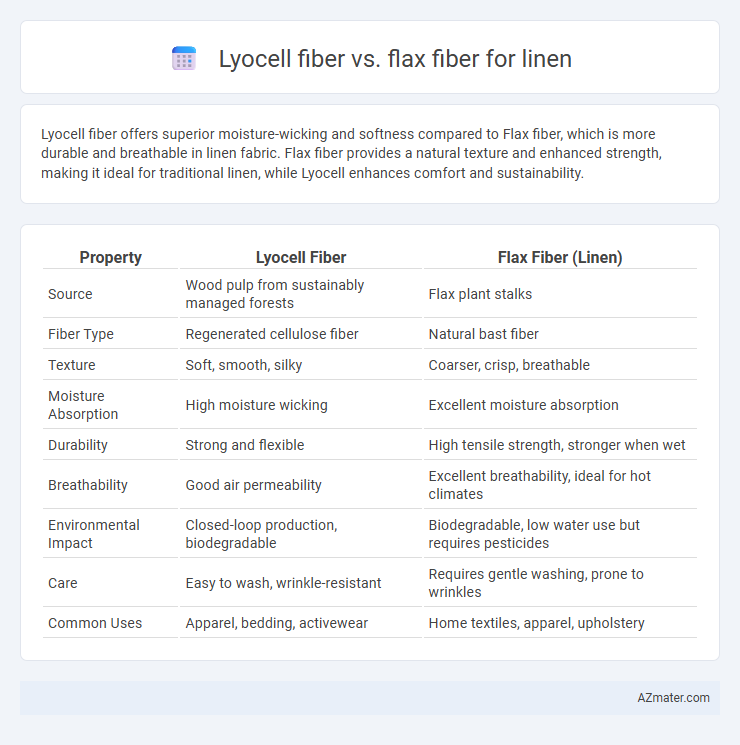Lyocell fiber offers superior moisture-wicking and softness compared to Flax fiber, which is more durable and breathable in linen fabric. Flax fiber provides a natural texture and enhanced strength, making it ideal for traditional linen, while Lyocell enhances comfort and sustainability.
Table of Comparison
| Property | Lyocell Fiber | Flax Fiber (Linen) |
|---|---|---|
| Source | Wood pulp from sustainably managed forests | Flax plant stalks |
| Fiber Type | Regenerated cellulose fiber | Natural bast fiber |
| Texture | Soft, smooth, silky | Coarser, crisp, breathable |
| Moisture Absorption | High moisture wicking | Excellent moisture absorption |
| Durability | Strong and flexible | High tensile strength, stronger when wet |
| Breathability | Good air permeability | Excellent breathability, ideal for hot climates |
| Environmental Impact | Closed-loop production, biodegradable | Biodegradable, low water use but requires pesticides |
| Care | Easy to wash, wrinkle-resistant | Requires gentle washing, prone to wrinkles |
| Common Uses | Apparel, bedding, activewear | Home textiles, apparel, upholstery |
Introduction to Lyocell and Flax Fibers
Lyocell fiber is a sustainable, cellulose-based fabric made from wood pulp, known for its softness, strength, and moisture-wicking properties, making it an eco-friendly alternative in textile production. Flax fiber, derived from the flax plant, is the traditional source of linen, valued for its durability, breathability, and natural luster. Both fibers serve as key materials in linen production, with lyocell offering modern manufacturing advantages and flax maintaining a long-standing historical significance in fabric creation.
Fiber Origins and Production Processes
Lyocell fiber is derived from sustainably harvested wood pulp, primarily from eucalyptus, and produced through a closed-loop solvent spinning process that recycles nearly all chemicals and water used, resulting in minimal environmental impact. Flax fiber originates from the flax plant's stalks, which undergo harvesting, retting (either water or dew), and mechanical scutching to extract the natural bast fibers essential for linen production. Both fibers offer unique textile qualities, but Lyocell's modern, eco-friendly production contrasts with the traditional agricultural and manual processing methods required for flax fiber extraction.
Environmental Impact Comparison
Lyocell fiber production utilizes a closed-loop process that recycles water and solvents, resulting in significantly lower water consumption and chemical waste compared to traditional flax fiber cultivation, which often involves pesticide and fertilizer use. Flax fiber, while biodegradable and renewable, requires large amounts of water and arable land and can contribute to soil depletion and greenhouse gas emissions during retting and processing stages. The sustainable advantages of lyocell make it a preferred choice for eco-friendly linen alternatives, offering reduced carbon footprint and minimizing environmental pollution.
Physical Properties and Performance
Lyocell fiber offers superior moisture-wicking and softness compared to flax fiber, making it ideal for breathable, comfortable linen fabrics. Flax fiber provides exceptional strength, durability, and natural luster, contributing to the traditional crisp texture and longevity of linen textiles. Both fibers exhibit excellent biodegradability, but Lyocell's smooth surface reduces pilling, while flax's irregular fiber structure enhances breathability and thermal regulation.
Comfort and Breathability
Lyocell fiber offers exceptional softness and moisture-wicking properties, making it highly comfortable and breathable for linen fabrics. Flax fiber, derived from the flax plant, provides natural cooling effects and superior air permeability, enhancing breathability and moisture absorption. Both fibers contribute to comfortable linen, but Lyocell excels in smooth texture while flax stands out for its natural ventilation and durability.
Durability and Longevity
Lyocell fiber offers superior durability and resistance to wear compared to flax fiber, making it ideal for long-lasting linen products. Flax fiber, traditionally used in linen, is strong but more prone to abrasion and thinning over time, reducing fabric longevity. The enhanced moisture-wicking and tensile strength of Lyocell contribute to extended fabric life and sustained performance in linen applications.
Moisture Absorption and Wicking
Lyocell fiber exhibits superior moisture absorption and wicking properties compared to flax fiber, making it highly effective for moisture management in linen fabrics. Lyocell's smooth, hydrophilic surface enables rapid moisture transport and evaporation, enhancing comfort and dryness. Conversely, flax fiber, while strong and breathable, absorbs moisture more slowly and has lower wicking efficiency, which can result in longer drying times.
Textile Applications and Versatility
Lyocell fiber offers enhanced softness, moisture-wicking, and durability compared to traditional flax fiber used in linen textiles, making it ideal for high-performance apparel and home textiles. Flax fiber remains prized for its natural breathability, strength, and eco-friendly properties, widely utilized in upholstery, drapery, and casual wear. Both fibers deliver versatility in textile applications; Lyocell integrates seamlessly with synthetic fibers for stretch and resilience, while flax maintains a classic, crisp texture favored in premium linen fabrics.
Cost and Market Availability
Lyocell fiber for linen offers a moderate cost solution with increasing market availability due to its eco-friendly production process and strong demand in sustainable textiles. Flax fiber, traditionally used in linen, tends to have higher costs driven by labor-intensive cultivation and processing but benefits from well-established supply chains and global market presence. The choice between Lyocell and Flax fibers hinges on balancing price sensitivity with material preference in evolving linen markets.
Conclusion: Which Fiber is Better for Linen?
Lyocell fiber offers superior moisture-wicking and softness, making it ideal for comfortable, breathable linens with a smooth texture. Flax fiber provides exceptional durability and natural luster, delivering traditional linen qualities with eco-friendly benefits from its biodegradable nature. For those prioritizing comfort and sustainability, Lyocell is recommended, while Flax remains the top choice for strength and classic linen aesthetics.

Infographic: Lyocell fiber vs Flax fiber for Linen
 azmater.com
azmater.com